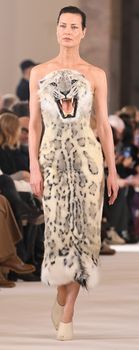I really miss the old days, when Manmohan Singh was prime minister and the economy was golden. This meant that international fashion houses were genuinely interested in making money out of India’s billion-plus populace, and arrived here with gargantuan glass-and-chrome stores, deep marketing pockets, and the most wonderful pony-up of them all—where fashion writers would be flown to Paris and Milan (business class!) to watch “the shows”.
Now, the shows we watch are on Instagram. John Galliano does not send us two dozen roses and a hand-written note to our five-star rooms. Yves Carcelle does not invite us over for breakfast at his office at 8am. The itsy-bitsy Valentino does not speak his halting English with us any more. Instagram fashion week it is.
This also means that fashion is less about clothes and more about seeking attention. We watch them on little hand-held phones, where a frock is a mere four inches tall. How to be memorable then? Ask Schiaparelli, they have been especially busy making conversation starters (or is it conversation-stoppers?) for fashion.
Their couture collection last Monday in Paris was inspired by the great Italian poet Dante’s vision of hell. Among the melting frocks were three show-stoppers—one dress featuring a lion’s head upfront, another a snow leopard’s, and the third a wolf’s. The Italian label won the eyeballs it was looking for with the internet disparaging the glamourisation of animals (fashion’s oldest activist peeve) and hunting. Although animal rights group PETA was perfectly kosher with the show as it was obviously made of foam, resin, and wool.
Never mind the aesthetics, fashion’s newest currency is the ability to emcee a conversation and steal the attention of editors, fans and influencers, even for a few minutes. Schiaparelli was the one that sent Bella Hadid down the red carpet in a black gown with bare breasts and a gold lung-fibre shaped necklace as a covering, almost like a tree that offers shade and oxygen to a tired, climate-addled soul. Chief designer Daniel Roseberry knows the importance of controlling conversations to hold the audience’s gaze.
A few days before and later, two young Indian men took their version of couture (lots of shimmer, lots of craft) to the Parisian runways. Couture week regular Rahul Mishra showcased ‘Cosmos’, a typical line layered with embroidered appliques. This is not a complaint, as one can never be tired of a beautiful thing. Mishra’s gardens were radiant with the hand-work of artisans, something that Europe cannot have enough of (and thus makes us Indians believe in our own magic). His 3D gowns were resplendent with his signature volume. Mishra has played faithful to his shapes over the last few years, and that may be a good thing if one is planning to be remembered on foreign shores.
The other was a first-timer in Paris. The talented Gaurav Gupta brought clever variations to his wired silhouettes. With Suzy Menkes and Vanessa Friedman in the audience, Gupta had to rely on his dreamlike shapes to let the mind’s eye fly with wonder. Gupta says his collection ‘Shunya’, or zero in Sanskrit, is an homage to fantasy and surrealism, much like Mishra’s magical tree of life or Schiaparelli’s hunting safaris.
In the rush to make social commentary the mainstay of a fashion collection, designers must now tread the tightrope between eyeball-grabbing marketing as well as ethical notions of clothing. Wearing a wild animal’s head on your chest may not be the best answer yet.
@namratazakaria


